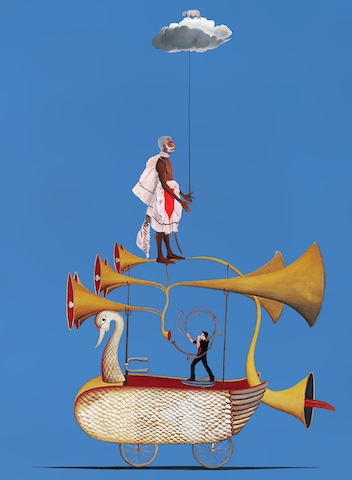The question of whether contemporary art from the Indian subcontinent must reconcile with the region’s artistic traditions continues to haunt its artists, curators and critics. One side of the argument is that art must remain connected to its ‘roots’; the other is that the burden of tradition is best left behind. Persevering Traditions: The weft and the warp, curated by Veer Munshi at Sakshi Gallery in Mumbai, brings together the work of 14 Indian artists, from revered modernists to younger practitioners, who have ‘borrowed from, been inspired by, negotiated with, or plainly imitated traditional forms’. This is a useful cue: the ‘persevering’ of tradition is here achieved through sampling and referring to symbolic forms with a specific cultural history.
These paintings and sculptures were hung in a tight formation that, given the exhibition’s premise, encouraged the viewer to look closely for historical precedents in the formal properties of each work. Anju Dodiya’s acrylic and gouache paintings on wallpaper, showing brooding figures floating in and out of decorative scenes, can be seen to reference Indian traditions of miniature painting, but the artist also cites seventeenth-century Flemish painting, the films of Ingmar Bergman and nineteenth-century French medical manuals as influences. Also working across different cultural histories, Surendran Nair, a painter from the Kerala school, references both Greek mythology – in particular the hybrid bodies of his ‘Cuckoonebulopolis’ series, set in a utopia based on Aristophanes’s The Birds (414 BCE) – and the formal compositions of the body that are particular to Kathakali, the seventeenth-century dance tradition of his native state.
K.G. Subramanyam, represented in the show by an untitled watercolour, was a teacher on the fine arts course at Baroda University, in Gujarat, where several artists in the show trained, and a founding father of Baroda modernism. When Subramanyam moved to the university after a split with Santiniketan and the Bengal school, the Baroda School became associated with a style that combined narrative figurative painting with European modernism. This is reflected in Subramanyam’s own work: he sourced figures from Kalighat and Santhal paintings, textile patuas, puppetry traditions and court painting.
Seen through the lens of regional Indian art history, the techniques and language employed by many of the artists in the show, including Gulammohammed Sheikh and Madhvi Parekh, continue modernist preoccupations (particularly in the formalised use of traditional motifs). But these symbols are themselves ambiguous, and to identify single historical influences in the works is reductive. Different art histories are specific to each region of the subcontinent: even the tradition of Mughal miniature painting shifts radically between different locales. In attempting to find broad precedents, these histories risk being flattened out, symptomatic of a tendency to neatly reduce complexity to trope. Perhaps there is a greater need to revisit the ways in which history has narrativised early modernist interactions with tradition than to investigate whether the traditions themselves persevere.
Persevering Traditions: The weft and the warp at Sakshi Gallery, Mumbai, 21 December – 19 January
From the Spring 2018 issue of ArtReview Asia
